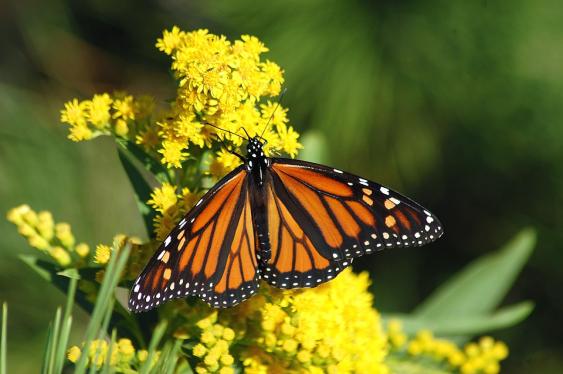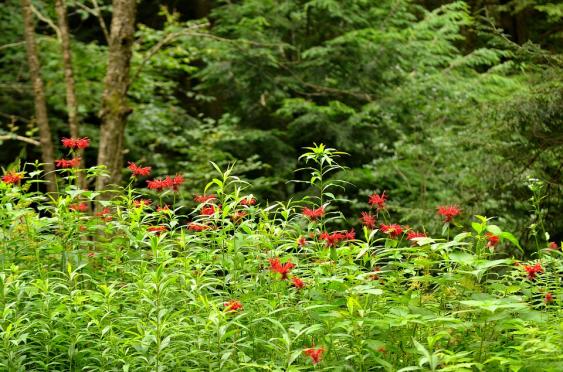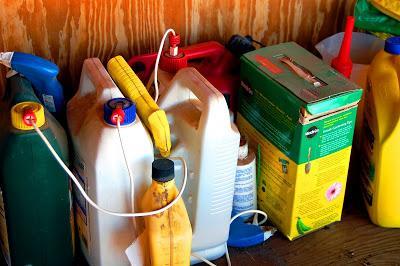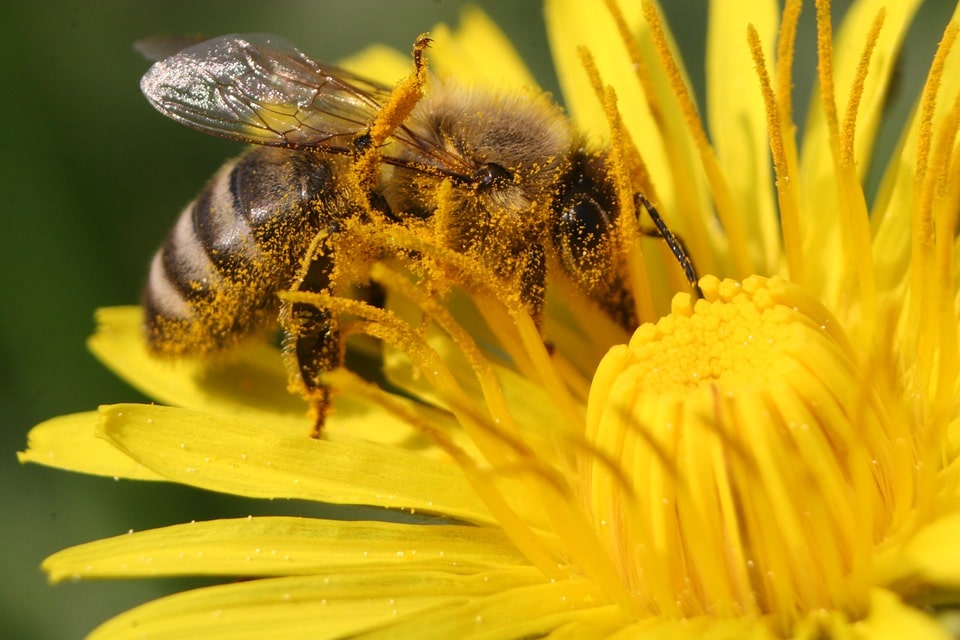Bees carry pollen over their entire body as they fly from flower to flower. Pixabay photo
Darlene Hofmeister volunteers as our guest blogger. She is a lifelong gardener and Master Gardener through Penn State Cooperative Extension’s program. She is currently participating in the PA Master Naturalists program through the Perkiomen Watershed Conservancy. Her love of education and desire to share knowledge with others continues past her 35-year teaching career. We are thrilled to have her share her insights about gardening.
Pollinators 101
Who doesn’t love to see butterflies floating through the garden? One of my favorite moments in the garden is watching the butterflies and teeming bees move from bloom to bloom. Pollinators are attractive and enthralling to watch which may be reason enough to attract them to our gardens. But beauty is only a small reason why pollinators are desirable in our gardens.

Monarch feeding. Pixabay photo.
What Are Pollinators and Why Do We Need Them?
Pollinators are animals (primarily insects including honey bees, native bees, butterflies, beetles, and flies) that move pollen from one flower to another of the same species to make fertile seeds. Pollen is moved from the anthers (male parts) of flowers to stigmas (female parts) resulting in fertilization. When flowers are fertilized, they produce seeds and fruit to ensure that plant reproduction takes place. Most fruits, vegetables, grains, nuts, and beans rely on insect pollination. In the United States alone, more than 100 crops valued at over $20 billion need pollination. Even our backyard vegetable gardens rely on pollination!
The relationship between pollinators and plants is mutually beneficial. Pollinators feed on nectar from the plants which provide them with carbohydrates to fuel their flights, and pollen to provide proteins, fats, vitamins, and minerals to feed their young.
Pollinators also allow for genetic diversity in plants which will help plants become more tolerant to changes in our environment such as global warming. They are insurance that our ecosystems will maintain healthy balances.

Bee Balm growing in the garden. Pixabay photo.
Why Are Pollinator Populations Diminishing?
Documentation has shown population declines and even extinctions in certain species of pollinators across the United States and Europe. Disease, parasites, and pesticides have caused honey bee populations to drop dramatically. Loss of flowers to pollinate as well as loss of habitats for pollinators to nest due to continuous land development both contribute to their decline.

Garden pesticides cause pollinator population to drop.
5 Things We Can Do to Increase Pollinator Populations
1. Plant a pollinator garden. The garden should include an assortment of flowering plants to offer pollen and nectar to all kinds of pollinators. Plant flower varieties in masses to encourage pollinator visits. Select native plants to feed native pollinators. Ensure that blooms are available throughout the growing season, spring to fall.
2. Provide nesting habitats for pollinators. Native bees generally nest in the ground so it is important to avoid use of plastic or weed cloth in your garden. Provide piles of brush and small branches around the perimeter of your property for chrysalises or cocoons. Leave rotten logs, stumps, bare soil, piles of stone, or clump forming grasses to act as nesting habitats for beetles and bees.
3. Provide water resources. Add a birdbath or small pond to your garden landscape!
4. Try to maintain a chemical free garden. The problem with pesticides is not only do they kill the intended pest targets, they have the same effect on beneficial plants and insects. Try to keep a balance between effectively managing pests and encouraging pollinator presence. If pesticides are used, follow the label directions precisely. Avoid contact with blooming plants and bee nesting spots. Use liquids rather than powders because powders can become trapped in the bee pollen. Spray in the evening when bees are less active and avoid spraying in the morning when dew covers plants to reduce chemical toxicity. Consider using pheromone traps as an alternative to spray.
Our organic-based lawn care program is one example of how Whitehouse Landscaping is passionate about using a sustainable approach to landscaping. Our organic lawn care program uses the least amount of fertilizer for an effective and naturally safe lawn treatment. It reduces the use of inorganic fertilizers in the landscape that are a potential threat to bees, birds and butterflies.
5. Become a beekeeper! Consider starting your own honeybee hive! Join a local beekeeping group to help you get started with this fascinating endeavor. Locally, the Montgomery County Beekeepers’ Association of Pennsylvania (www.montcopabees.org) furnishes resources, services, and education for inspiring and practicing beekeepers. If having your own beehive seems daunting, focus on attracting native bees such as mason bees and leafcutters by supplying nesting boxes.
What Plants Attract Pollinators to Your Garden?
Look for native flowering shrubs and plants since they are most attractive to pollinators. Remember to choose a variety of plants that ensure blooms in your garden from early spring through late fall. Penn State Extension’s 2015 pollinator trial showed the top ten plants for total pollinator visits over 3 years. The top ten plants were: Mountain mint, stiff goldenrod, rattlesnake master, gray goldenrod, thoroughwort, blazing star, Joe-pye weed, swamp milkweed, wild bergamot, and smooth aster. Sunflowers, asters, bee balm, tickseed, and Culver’s root appeared on the top 20 list. Consider adding some of these varieties and others to your garden. Look for pollinator plants at your local garden center. Most labels today indicate pollinator preferences.
Now enjoy the beauty! Sit back and enjoy the beauty of both your garden and the visiting pollinators!
Providing a pollinator habitat can be rewarding and fun. If you’re looking to make a beautiful landscape available for pollinators, but don’t have the time to commit to making it happen, let us help you design and maintain the perfect landscape to fit your needs. Whitehouse Landscaping has a comprehensive knowledge of plants so that you get the right plant that grows to the right size for the right place in your garden. Our landscaping, organic-based lawn care and maintenance experience can help bring a plan to life that is pleasing to the eye, functional and sustainable. Call us at 484-300-4290 or fill out a contact form on our website to see how we can help you with your landscape needs.

